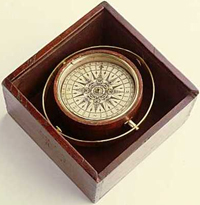|
|
|
 |
The Mariner's Compass
 By the late sixteenth century, the
mariner's compass had evolved into an
instrument not very different from the
compass of today. By the late sixteenth century, the
mariner's compass had evolved into an
instrument not very different from the
compass of today.
In ancient times, the physical housing
of the
compass itself was typically made from
wood or ivory. Later, brass came into use
as the metal was much more durable than
those softer materials and the
non-ferrous properties of brass was
confirmed to not affect the behavior of
the magnetic needle.
The Pole Star (Polaris) served as the
seaman's lodestar (or star that shows
the way). Therefore the magnetic stone
which was used to magnetize the compass
needle was called a lodestone. The
magnetic, direction-finding property of
the lodestone had been discovered in
China as early as the twelfth century.
 By the sixteenth century, the
design of the mariner's
compass had evolved slightly. The
interior of the compass had replaced
it's simple magnetized rod with a soft iron wire
bent to a lozenge shape and attached to
the underside of a circular compass
card, which was suspended at the center
on an upright needle. By the sixteenth century, the
design of the mariner's
compass had evolved slightly. The
interior of the compass had replaced
it's simple magnetized rod with a soft iron wire
bent to a lozenge shape and attached to
the underside of a circular compass
card, which was suspended at the center
on an upright needle.
Because the iron wire tended to lose its
magnetism over a period of time, it was
necessary for each ship to carry a good
lodestone to re-magnetize the wire when
it weakened.
 Despite
the design improvements of the mariner's compass,
it did have a significant flaw: The
magnetized wire in the compass was drawn
by large land masses. This caused the
compass to have variations in its
readings. Despite
the design improvements of the mariner's compass,
it did have a significant flaw: The
magnetized wire in the compass was drawn
by large land masses. This caused the
compass to have variations in its
readings.
The mariners and
mathematicians of this early period were
concerned about this problem, and a
number of corrective measures were
tried. However, at the time the
Mayflower sailed in 1620, the problem
had not been satisfactorily solved. |
Click on the Piece of Eight to return to the Main Page
 |
|
 |
|
|
|

